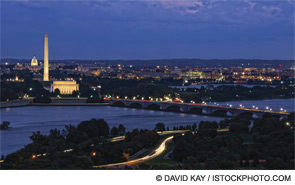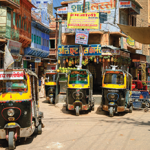
Immediately after the ACR meeting in Philadelphia in October, I had the honor and good fortune to attend the 2009 Bone and Joint Decade (BJD) Network Conference in our nation’s capitol. The BJD is an international organization that, since 2000, has promoted worldwide awareness of musculoskeletal disease, interacting with governmental and non-governmental agencies to develop innovative programs for prevention and treatment of musculoskeletal conditions. The ACR was a founding member of the BJD and has actively contributed to BJD activities over the years through the work of many ACR members.
The Washington, D.C. conference highlighted BJD activity and featured presentations on the burden of disease, recent advances, and prospects for the future. For a rheumatologist, the expected areas of attention included inflammatory arthritis, osteoarthritis, and osteoporosis. The focus of the BJD is much, much larger, however, and encompasses such disparate areas as civilian and military trauma, rehabilitation, spine disorders, and congenital malformations. Hearing a lecture on clubfoot, I was shocked by the awful toll that this condition can take, not only in pain and disability, but also in stigmatization and ostracism. In some parts of the world, a clubfoot can deprive a person of education and social standing. The advent of a nonoperative approach to correcting clubfoot, called the Ponseti method, could have far-reaching benefits and, in an inexpensive and highly effective way, alleviate great suffering.

Around the globe today, motor vehicle accidents rank as one of the major hazards to bone and joint health. In the United States, the carnage results largely from drunk driving and the mystifying behavior of those who think they can use cell phones and send text messages while catapulting down the highway. In the developing world, the culprits are hazardous roads, poor vehicles, and a situation called heterogeneous traffic. In heterogeneous traffic, pedestrians, trucks, automobiles, bicycles, scooters, horses, and donkeys vie for access on the same road. The differences in these conveyances lead to mayhem and deadly collisions, where speed and size determine the winners and losers.
Lessons from Around the Globe
As is the case at any international meeting, the opportunity to meet individuals from other countries and hear of the challenges in medicine overseas is always enlightening and often sobering. Certain events obviously have enormous medical consequences that unfortunately can quickly be forgotten. In the rush of 24/7 news coverage, the media fixate on wrenching images of immediate tragedy and then move on, neglecting the longer-term effects. Among its devastating legacies, the Sichuan earthquake in China produced hundreds of children who had to have amputations to remove crushed limbs. The efforts of the Stand TALL project from Hong Kong to provide prostheses and encourage rehabilitation signify the practice of medicine in its most selfless and compassionate way.
On Friday night at the conference, we went to a dinner in an office building near Foggy Bottom. Because this building had two floors of State Department offices, security was high. We had to show picture IDs and undergo a search worthy of the airport where both our belongings and bodies were scanned with metal detectors. Happily, we all made it through with flying colors and could share the festivities together.
There is no city in the United States that can produce vistas as stirring and majestic as Washington, and we were lucky to have a brilliant, clear night. From our vantage on the top floor of the building, we could see all of the monuments shining under the evening sky as flickering wing lights demarcated the roaring descent of planes to Reagan National Airport.
After champagne and hors d’oeuvres, I sat down at a table with people from four continents. While enjoying salmon and a fine pinot noir, I spoke to one of three rheumatologists in the whole country of Kenya and heard of his struggles to treat inflammatory arthritis with old medicines that were nevertheless in short supply. On the other side of the table, a rheumatologist from South Africa relayed a similar story of treating the very poor in his country, emphasizing the need for education about new treatments and the value of contacts between rheumatologists from the developed world and his staff. Although the United States has great medical needs, these can pale in comparison with those of much of the rest of the world, where access to care can seem precarious if not illusory.
Vision for the Next Decade
One of the goals of the conference was the establishment of an agenda for the future, as the “decade” becomes “the decades.” We had two preliminary sessions before an assembly of the whole conference. The first session divided us by interest, such as arthritis, spine disease, and trauma. In the second session, we were re-sorted by region, including North America, South America, Middle East, Europe, Africa, Asia, and the Pacific. In these groups, using an informal Delphi process, we established priorities both for our disease area (e.g., increased recognition of early inflammatory arthritis) and our region (e.g., increased multidisciplinary research). The process will continue in the coming years, but I came away with the strong feeling that the time is right for American (and European) rheumatologists to expand their perspective and adopt a more global view.
Among the less profound things that I learned at the conference was the difference between shaking hands with rheumatologists and orthopedic surgeons, of whom there were many. Because they wield hammers and saws and yank and pull bones each day, surgeons acquire very strong hands. Unwittingly, when they shake hands, the hard bones of their hands inflict a crushing blow, smashing fingers together, as if to require their immediate medical attention after the greeting is over. In comparison, rheumatologists, because they are cognitive specialists, have smooth and gentle hands. Their grips are safe. There is nothing to fear from contact with such brainy people.
Although my fingers came home swollen and bruised, I was happy join my compadres from the operating room in a very worthwhile endeavor. The orthopedists of the world are doing great work. As rheumatologists, we need to learn more about their remarkable accomplishments. The BJD has been a great place for this interaction, and I wish it a long life and great success in the future.
Dr. Pisetsky is physician editor of The Rheumatologist and professor of medicine and immunology at Duke University Medical Center in Durham, N.C.

